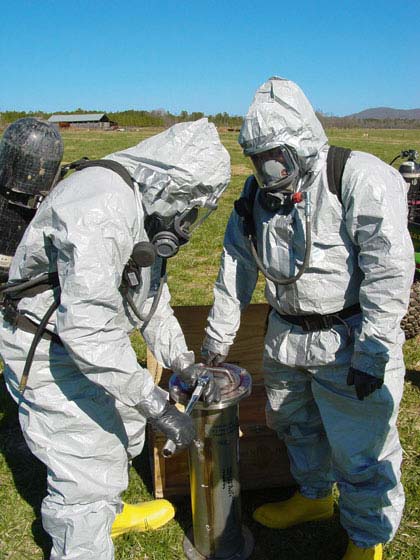Selection of Chemical-Protective Clothing (CPC)
Selection of Chemical-Protective Clothing (CPC)
Chemical-protective clothing (CPC) is available in a variety of materials that offer a range of protection against different chemicals. The most appropriate clothing material will depend on the chemicals present and the task to be accomplished. Ideally, the chosen material resists permeation, degradation, and penetration.
Permeation is the process by which a chemical dissolves in and/or moves through a protective clothing material on a molecular level. Degradation is the loss of or change in the fabric's chemical resistance or physical properties due to exposure to chemicals, use, or ambient conditions (e.g., sunlight). Penetration is the movement of chemicals through zippers, stitched seams or imperfections (e.g., pinholes) in a protective clothing material. Selection of chemical-protective clothing is a complex task and should be performed by personnel with training and experience. Under all conditions, clothing is selected by evaluating the performance characteristics of the clothing against the requirements and limitations of the siteand task-specific conditions. If possible, representative garments should be inspected before purchase and their use and performance discussed with someone who has experience with the clothing under consideration. In all cases, the employer is responsible for ensuring that the personal protective clothing (and all PPE) necessary to protect employees from injury or illness that may result from exposure to hazards at the work site is adequate and of safe design and construction for the work to be performed (see OSHA standard 29 CFR Part 1910.132, 1910.137).

Permeation and Degradation
The selection of chemical-protective clothing depends greatly upon the type and physical state of the contaminants. This information is determined during site characterization. Once the chemicals have been identified, available information sources should be consulted to identify materials that are resistant to permeation and degradation by the known chemicals. One excellent reference, Guidelines for the Selection of Chemical-Protective Clothing, provides a matrix of clothing material recommendations for approximately 300 chemicals based on an evaluation of permeation and degradation data from independent tests, vendor literature, and raw material suppliers. Charts indicating the resistance of various clothing materials to permeation and degradation are also available from manufacturers and other sources. It is important to note, however, that no material protects against all chemicals and combinations of chemicals, and that no currently available material is an effective barrier to any prolonged chemical exposure.
Employers should review vendor literature, it is important to be aware that the data provided are of limited value. For example, the quality of vendor test methods is inconsistent; vendors often rely on the raw material manufacturers for data rather than conducting their own tests; and the data may not be updated. In addition, vendor data cannot address the wide variety of uses and challenges to which CPC may be subjected. Most vendors strongly emphasize this point in the descriptive text that accompanies their data. Another factor to bear in mind when selecting CPC is that the rate of permeation is a function of several factors, including clothing material type and thickness, manufacturing method, the concentration(s) of the hazardous substance(s), temperature, pressure, humidity, the solubility of the chemical in the clothing material, and the diffusion coefficient of the permeating chemical in the clothing material. Thus permeation rates and breakthrough time (the time from initial exposure until hazardous material is detectable on the inside of the CPC) may vary depending on these conditions.
Mixtures of chemicals can be significantly more aggressive towards CPC materials than can any single component alone. Even small amounts of a rapidly permeating chemical may provide a pathway that accelerates the permeation of other chemicals. Formal research is being conducted on these effects. NIOSH is currently developing methods for evaluating CPC materials against mixtures of chemicals and unknowns in the field. For hazardous waste site operations, CPC should be selected that offers the widest range of protection against the chemicals expected on site. Vendors are now providing CPC material composed of two or even three different materials laminated together that is capable of providing the best features of each material.
Heat Transfer Characteristics
The heat transfer characteristics of CPC may be an important factor in selection. Since most 40 hour HAZWOPER chemical-protective clothing is virtually impermeable to moisture, evaporative cooling is limited. The "clo" value (thermal insulation value) of chemical-protective clothing is a measure of the capacity of CPC to dissipate heat loss through means other than evaporation. The larger the clo value, the greater the insulating properties of the garment and, consequently, the lower the heat transfer. Given other equivalent protective properties, clothing with the lowest clo value should be selected in hot environments or for high work rates. Unfortunately, clo values for clothing are rarely available at present.

